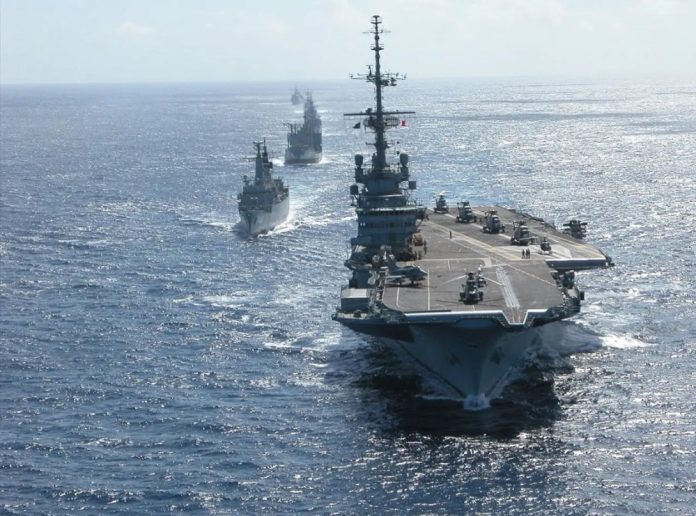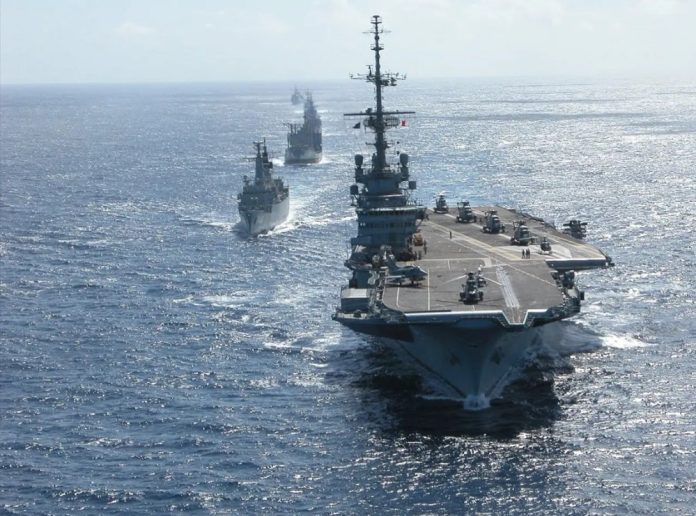
The former Brazilian aircraft carrier Sao Paulo could find its final destination at the bottom of the Atlantic Ocean after discovering that its condition might be too poor for transit to be scrapped and after it was denied entry into ports in Turkey and Brazil.
The 870-foot-long (265 m) aircraft carrier, which had served the French Navy as Foch before being transferred to Brazil in 2000, still contains a significant amount of harmful asbestos, raising concerns about new plans of the country’s environment minister, among others.
The Brazilian media have recently echoed the proposal to sink the old Sao Paulo in the Atlantic. According to these accounts, the ship had been towed 20 nautical miles from Suape, one of Brazil’s main ports, in Pernambuco, in the northeast of the country, since January 13, when a technical inspection took place.
Experts discovered that the state of the warship was worse than they had anticipated, with “a new break in the vessel, increased amount of flooding, and corrosion compared to the examination conducted out four months earlier.”
The government of freshly elected President Luiz Inácio Lula da Silva appears to favor sinking Sao Paulo due to its advanced state of decay. At the same time, no final decision has been taken. Additionally, the ship’s damage makes her hull unsuitable for passage on the open sea, severely limiting her future uses.
The original plan was to tow the ship to Turkey, where it would be broken up by Sok Denizcilik Ticaret, one of the country’s leading shipbreaking and recycling companies.
The Brazilian Navy sold the former Sao Paulo to the company last year, but it had to turn around in August because the Turkish government would not let it into its waters because of protests about how dangerous asbestos could be. The Turkish company has given up on taking over the ship.

Since returning to the Brazilian seas in September, the warship has been stuck in limbo as various local ports have refused entry. This has introduced the possibility of sinking the carrier at sea, using “a series of explosions to blow holes in the hull,” according to the media.
It is unclear if the sinking would be carried out using explosive charges attached to the ship or if the Brazilian Navy could carry out a sinking exercise or SINKEX.
These exercises involve using weapon systems, from planning the attack to launching the missile or torpedo, providing valuable training experience to the crews involved, and demonstrating that the weapons can destroy targets in the real world. They also act as weapons testing and validation exercises.
Whatever the method used to sink the aircraft carrier, it appears that the asbestos it carries on board will remain a controversial issue. Marina Silva, Brazil’s environment minister, is perhaps the most prominent figure opposing the sinking so far, according to the Folha de S. Paulo newspaper.
According to the Brazilian Navy, the ship had even more asbestos removed in the 1990s when some 55 tonnes were taken off the ship. The remaining asbestos is now found in the ship’s walls, providing thermal and acoustic insulation, the latter a requirement of the fast-moving reactors on the upper deck.
The Navy has sole authority over the aircraft carrier’s future, which only adds to the complexity of the problem. While investigating the military’s role in the attack on the Brazilian Congress, the Presidential Palace, and the Court.
Supreme continues, the da Silva government is widely regarded to be unwilling to enter into a confrontation with the armed services generally. The latest development is a sad end to the old Sao Paulo, once the pride of the Brazilian Navy fleet but always of dubious operational value.
In September 2019, the Brazilian Ministry of Defense began the auction process for the retired aircraft carrier, having formally decided to decommission it two years earlier.

Originally commissioned into the French Navy as the Foch in 1963, the warship was the second of two Clemenceau-class aircraft carriers and remained in service with France until 2000. Brazil acquired it that same year for just $12 million to replace the previous Minas Gerais, a British Colossus-class aircraft carrier that the Brazilian Navy withdrew in 2001.
Sao Paulo was one of just three countries that still operated aircraft carriers when it pulled out. The design allows both a catapult launch and a barrier-assisted landing (CATOBAR)

Ultimately, despite the undoubted prestige of operating a CATOBAR aircraft carrier, Sao Paulo did not live up to expectations and, before her decommissioning, had lain virtually inactive for over a decade. Before that, an explosion in the steam catapult system in 2004 killed a sailor and required a major overhaul that spanned 2005-2010.
A deadly fire followed in 2012, necessitating further upgrades and reducing her time at sea. Sao Paulo had only spent 206 days at sea under the Brazilian flag at the time of her withdrawal from her.
The withdrawal of Sao Paulo left the fate of the Brazilian Navy’s carrier-based AF-1 Skyhawk fighter jets in limbo. However, work has continued on the modernization of these aircraft to guarantee their viability, even though they now operate from a land base in São Pedro da Aldeia.
In April of last year, Embraer concluded the Skyhawks modernization contract with the delivery of the latest aircraft.
Five single-seaters and two double-seaters were upgraded to AF-1B and AF-1C standards, respectively, reducing numbers after Sao Paulo’s retirement. Now that Saab Gripen E/F fighters are joining the Brazilian Air Force, maintaining a larger Skyhawk fleet is also less important.
The seven modernized Skyhawks have received airframe and engine revisions, a new EL/M-2032 multi-mode radar from Elta Systems, a glass cockpit with hands-on-throttle-and-stick (HOTAS) controls, and other upgrades. This should keep them in service for another decade or so.
For the time being, plans to replace the Skyhawks with a navalized form of the Saab Gripen have been shelved, and a new aircraft carrier has not yet been introduced in Brazil.
Instead, Brazil acquired the ex-HMS Ocean, a helicopter carrier, from the UK in 2018 for approximately $115 million. Now known as the A140 Atlantic, this warship is restricted to rotary wing operations only.
In short, the protracted and costly efforts to keep Sao Paulo in service, followed by the problematic question of getting rid of her now that she is no longer needed, speak to the more general challenges posed by operating an aircraft carrier of any kind.
Whether this warship ends up at the bottom of the Atlantic or a way is found to dismantle it more safely elsewhere, it will likely be the last fixed-wing aircraft carrier operating in Brazil or anywhere in South America for a long time, if not ever.





